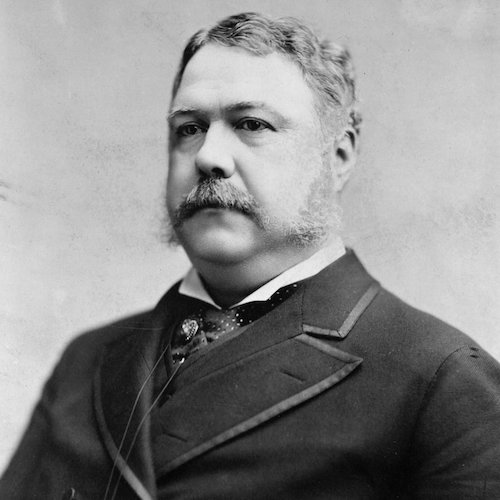Chester A. Arthur was the 21st President of the United States from 1881 to 1885. He was Vice President when President James Garfield was assassinated. The assassin, a disappointed job seeker, proclaimed, “I am a Stalwart and Arthur will be president now.”
Early Life
Arthur was born October 5, 1829, in Fairfield, Vermont. He graduated from Union College in 1848 and then studied law. In the beginning stages of his legal career, he argued and won a case that led to the desegregation of the New York City streetcar lines. He married Ellen Herndon and had three children. She died shortly after the 1880 election, so Arthur was a widower while in office.
During the Civil War, he was Engineer-in-Chief of the New York Militia and Quartermaster General of the State of New York.
Political Career
He was the Chairman of the New York Republican Party and became associated with Roscoe Conkling’s Stalwart political machine. President Ulysses S. Grant appointed him the Collector of the Port of New York, a position that controlled hundreds of well-paying jobs.
At the 1880 Republican Convention, Conkling and the Stalwarts fought for their candidate. In the end, they accepted Arthur’s nomination as Vice President.
Presidency
Arthur was a handsome man and is remembered for his bushy sideburns. He had a very active social life and entertained a great deal.
Despite his history of controlling patronage for votes, Arthur tried to run the government honestly and efficiently. He surprised everyone by supporting civil service reform so that government workers would be hired and promoted based on merit, not politics. As President, Arthur signed the Pendleton Civil Service Act of 1883, which established the Civil Service Commission.
He signed the Chinese Exclusion Act (1882) that suspended Chinese immigration to the United States for 10 years. He also recommended the transformation of the United States Navy into one of the world’s great fleets. He acquired a naval coaling station at Pearl Harbor.
Arthur died on November 18, 1886. During his presidency, he had been diagnosed with a fatal kidney disease.






